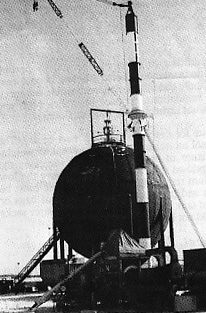FOR EVACUATED CRYOGENIC SERVICE
Expanded perlite is used for a wide variety of insulating applications ranging from cryogenic vessels requiring "super" insulation to low temperature and high temperature applications, lightweight perlite insulating concrete, insulating board, insulating plasters, masonry wall insulation, and underfloor insulation. Perlite "Super" Insulation For cryogenic applications of -150 F (-101 C) and below requiring "super" insulation, evacuated perlite provides a superior insulation with thermal conductivity up to 40 times less than 0.200 Btu.in/h.ft3F (0.029 W/m.K) depending on vacuum and temperature. Usual applications for evacuated perlite insulation are in double walled helium and hydrogen storage spheres. It also may be used for storage of oxygen, nitrogen, and LNG when especially low thermal conductivities are desired. In addition to large field erected storage tanks, evacuated perlite is used to insulate smaller shop fabricated vessels designed for the storage of many of the cryogenic gases. Properties of Perlite Insulation Perlite insulation suitable for evacuated cryogenic service exhibits low thermal conductivity throughout a range of temperatures, pressures, and densities. The normal recommended "in place" density range is 8 to 9.5 lb/cf3 (128-152 kg.m3). A graph providing data on thermal conductivity for expanded perlite a density of 8.7 lb/ft3 at mean temperatures from 0 F to -160 F is available from The Perlite Institute (www.perlite.org). Cryogenic temperatures are generally considered to be below -150 F. Thermal conductivity of evacuated perlite is many times lower than that of nonevacuated perlite insulation. For example, at a mean temperature of -115 F (-82 C), normal unevacuated cryogenic perlite at 4 lb/ft3 (64 kg/m3) would have a thermal conductivity about 22 times as great as evacuated perlite at 8.7 lb/cf3 (139 kg/m3) and interstitial pressure of 10 microns. In addition to excellent thermal properties, perlite insulation is relatively low in cost, easy to handle and install, and does not shrink, well, warp or slump. It also is noncombustible and meets fire regulations and can reduce insurance costs. Perlite for evacuated service must be dry. The normal moisture limit is 0.1 percent by weight. Moisture in the perlite greatly increases the pumpdown time necessary to achieve the low vacuum required. As a result, perlite must be fresh and packaged in moisture-proof bags or sealed tank trucks. Perlite bagged in paper sacks should not be used. Typical Evacuated Perlite Installation Field installation of perlite "super" insulation for large evacuated cryogenic vessels requires that a vacuum be maintained in the annular space of the vessel being insulated. Expanded perlite is pressurized with nitrogen in a tank truck and drawn into the annular space by a combination of vacuum and pressure. For small vessels, where vacuum transfer is not practical, direct conveying of dry perlite by means other than vacuum, under strictly controlled conditions, produces satisfactory results. Portable perlite expansion plants complete with dust control equipment and an intermediate two-compartment tank truck can be used to expand the perlite on-site and to fill the annular space with evacuated cryogenic grade perlite insulation in a relatively dust-free, moisture-free manner on very large jobs.
* Tests have shown that the finer the material the better its performance (within the specified density ranges which are given as the density of the perlite when compacted.)
The Schundler Company can provide perlite for cryogenic applications but does not do any installation work. For help in installing perlite cryogenic perlite or in cryogenic projects, contact:

INSULATION SPECIFICATIONS
Density 8 to 9.5 lb/ft3 (128 to 152 kg/m3)
Sieve Analysis (U.S.Standard) Maximum 5% plus 30 mesh (0.6 mm)*
Thermal Conductivity** 0.0047 Btu.in/h.ft2.F (0.0007 W/m.K)
** Thermal conductivity depends on temperature, density, the sieve analysis of the expanded perlite, and the interstitial pressure.
or contact them at:
Keltech Energies Ltd.*
'Chowgule House' 3rd Floor
18 Crescent Road
Bangalore--560 001
INDIA
email: santoshchowgule@vsnl.com
W.H.Waugh Consultants in Nashville, Tennessee has worked with cryogenic projects for years--providing both perlite and technical consulting: email: whitneywaugh@aol.com
If you need any more information or think we can help in any way, please call us or contact us at:
The Schundler Company
10 Central Street
Nahant, MA 01908
732-287-2244 or www.schundler.com
Back to Industrial Products Main Page